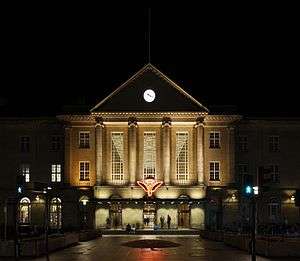Aarhus Central Station
Aarhus Central Station Aarhus Hovedbanegård | |
|---|---|
 Front facade of Aarhus Central Station by night | |
| Location |
Banegårdspladsen, Aarhus Denmark |
| Coordinates | 56°09′00″N 10°12′17″E / 56.15000°N 10.20472°ECoordinates: 56°09′00″N 10°12′17″E / 56.15000°N 10.20472°E |
| Operated by |
DSB Arriva Deutsche Bahn |
| Line(s) |
Fredericia-Århus Line Aarhus-Aalborg Line Odder Line Grenaa Line |
| Platforms | 3 |
| Tracks | 6 |
| Other information | |
| Fare zone | 01 |
| History | |
| Opened | 1862 |
| Rebuilt | July 1929 |
| Location | |
 Aarhus Central Station | |
Aarhus Central Station (Danish: Aarhus Hovedbanegård, abbreviated Aarhus H) is the main railway station serving the city of Aarhus, Denmark. Serving as the main connecting hub for rail traffic between Aarhus and the rest of Denmark, the station is used by an average of 6.3 million people per year, making it the busiest station in Denmark outside the Copenhagen area. It is located in the city centre between the districts of Midtbyen and Frederiksbjerg with entrances from Banegårdspladsen and the shopping centre Bruun's Galleri, and with access to platforms from M.P. Bruuns Gade.
It is a through station with 3 platforms. The station is located on the East Jutland railway, and is the terminus of the Grenaa Line and Odder Line. It offers international connections to Hamburg and Berlin, InterCity connections to Aalborg/Frederikshavn and Copenhagen, regional connections to the rest of Jutland as well as commuter rail services to Grenå and Odder. The train services are operated by DSB, Arriva and Deutsche Bahn.
History
The first railway station in Aarhus was built in 1862 near Ryesgade and served the Aarhus-Randers railway line. It was constructed by the civil engineering company Peto, Brassey and Betts, and encompassed administration buildings and railway works.

In 1884, a new and larger station building was constructed. The second station was built in Neo-Renaissance style by Thomas Arboe and William August Thulstrup and was possibly inspired by Bonn Central Station.[1][2]
However, also this building turned out to be to small for the quickly developing city. The third and current Aarhus Central Station was built in 1927 by the Danish State Railway's architect K.T. Seest as a part of a plan of the whole area around the station.
Station facilities


The station is connected to a shopping centre with 93 stores and future planning of expansion over the railway yard. Aside from a large ticket kiosk, the station has a McDonald's restaurant, two 7-Eleven's, and a couple of other shops.
The railway terminal has a flow of 13 million people per year.
Operations
Aarhus Central Station serves the whole of Denmark with inter-city rail and Jutland with regional rail. There are regional connections to Herning/Skjern and Struer, and commuter rail services to Odder and Grenå.
Since December 2012 the Aarhus Nærbane combined the services from Odder and Grenå into one suburban railway, which will be electrified by 2016.
Services
The following services currently call at the station:
- Intercity Express services Aarhus - Fredericia - Padborg - Flensburg - Hamburg - Berlin
- Intercity services Frederikshavn - Hjoerring - Aalborg - Aarhus - Fredericia - Odense - Copenhagen - Copenhagen Airport
- Regional services Aarhus - Horsens - Fredericia - Kolding - Esbjerg
- Regional services Herning - Silkeborg - Aarhus
- Local services Struer - Skive - Viborg - Aarhus
- Local services Skjern - Herning - Silkeborg - Aarhus
- Local services Odder - Aarhus - Skødstrup - Ryomgård - Grenaa
| Preceding station | Danske Statsbaner | Following station | ||
|---|---|---|---|---|
Skanderborg toward Copenhagen Airport | Copenhagen - Frederikshavn InterCityLyn | toward Frederikshavn |
||
| Copenhagen - Frederikshavn InterCity | toward Frederikshavn |
|||
| Copenhagen-Aarhus-Struer InterCity | toward Struer |
|||
| Terminus | Aarhus-Aalborg-Frederikshavn Regional train | toward Frederikshavn |
||
Kongsvang toward Odder | Aarhus Commuter Rail Commuter train | Europaplads toward Grenaa |
||
| Preceding station | Arriva | Following station | ||
Viby Jylland toward Skjern | Aarhus - Skjern Regional train | Terminus | ||
| Terminus | Aarhus - Struer Regional train | toward Struer |
References
- ↑ Christiansen, Asger. 1884: Ny hovedbanegård i Aarhus", Jernbanehistorisk Årbog 2009.
- ↑ Østerby, Mads (1984). Danske jernbaners byggeri. Et rids af et forløb (1844-1984). Odense Universitetsforlag.
External links
![]() Media related to Århus Hovedbanegård at Wikimedia Commons
Media related to Århus Hovedbanegård at Wikimedia Commons